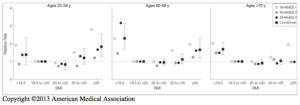When we face immediate danger, our bodies go through a physiological reaction to help us handle stress very quickly. This reaction is known as your “fight or flight” stress response. The stress response not only increases your heart rate and blood pressure, but also slows down digestion, growth, and reproduction while it numbs pain and suppresses the immune system. Evolutionarily, these adaptations were a good thing – they helped us run away from lions! However, the stressors we face nowadays are seldom the type that require a literal “fight or flight” (when is the last time a saber-tooth tiger was chasing after you?). Chronic stress more often comes in heavy workloads, time management, and money struggles, so what happens to our bodies when we have a physiological stress response to these types of stressors?
Hans Selye, M.D., Ph.D. (1907-1982) introduced the General Adaption Syndrome (G. A. S.) concept to explain the three stages of interrelated adaptive reactions to non-specific stress: the Alarm Reaction, the Stage of Resistance, and the Stage of Exhaustion. During the first stage, the body recognizes danger and the “fight or flight” response sets off by the activation of the HPA axis, the sympathetic nervous system, and the adrenal glands. The problem occurs when the energy provided by the main stress hormones cortisol, adrenaline, and noradrenaline are not used by physical activity and excess production of cortisol remains in the body. The body then shifts into the resistance stage, where homeostasis begins to restore balance and repair damages. Here, the problem occurs when chronic stress puts the body in a state of arousal with little or no recovery time. At the final stage, stress level remains high and the body’s adaptation energy supply is burnout, causing damaged nerve cells and adverse function of the autonomic nervous system. Selye’s theory was that stress is the major cause of disease because chronic stress causes long-term chemical imbalance in the body. The passage below is from the original article:
“Why does exposure to the same stressor produce disease only in certain Individuals?
It is undoubtedly true that the same drug, microbe, emotional irritant, or physical injury may produce a disease of adaptation in one person and be tolerated with impunity by another. It should be recalled, however, that the general adaptation syndrome is a useful, normal physiological reaction to stress; only its derailments have been interpreted as diseases of adaptation. Hence exposure to a stressor can be expected to produce such diseases only if the defence reaction is inadequate. Thus, for instance, in our experimental efforts to produce the hyalinosis-hypertension syndrome in rats by exposure to cold we found it necessary to perform unilateral nephrectomies and to keep the animals on high sodium, high-protein diets. All these conditioning circumstances failed to produce disease in the absence of stress, but upon exposure to cold they caused a derailment of the general adaptation syndrome, with consequent cardiovascular lesions, nephrosclerosis, and a rise in blood pressure. It is very probable that ill man also, under the influence of stress, similar diseases would develop only when the general adaptation syndrome is prevented from evolving in a normal manner, as a result of adverse conditioning factors.”
Ultimately, with high levels of stress, we also see increases in health problems and diseases. This is where the DiSH Lab comes in, as Selye’s G.A.S. model has inspired and guided our focus on chronic stressors such as dieting and weight stigma to understand the impact on physical health.


